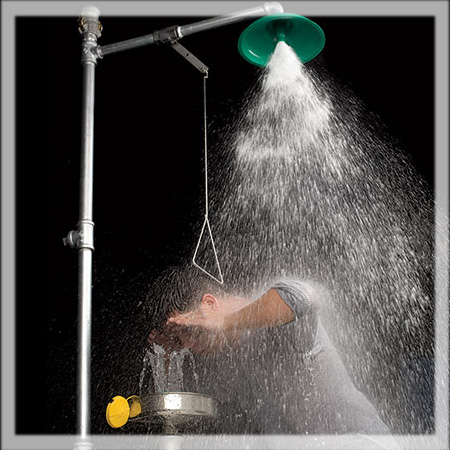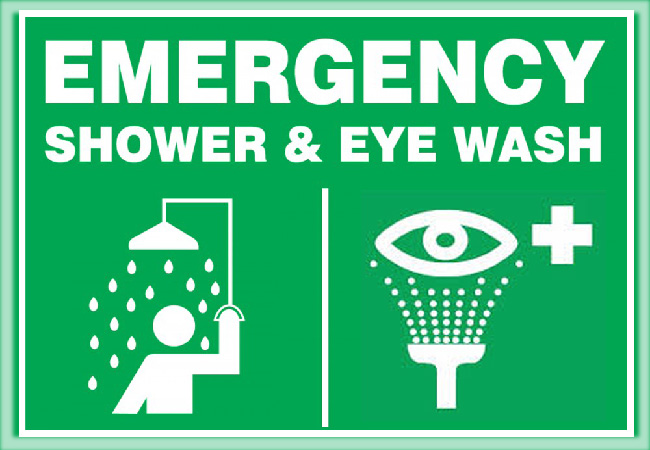Currency
June 06, 2018

Emergency eyewash systems and drench showers should be easy to access and readily available with tepid water. But as many safety facility managers will attest, these potentially life-saving fixtures aren’t always easy to provide in locations where they are required.
Lack of space
Plumbing requirements
Sub-zero temperatures
Extreme heat
Elevated hazards
High winds
Mobile operations
Budget limitations
Lack of plumbed water
High salt environments
Corrosive environments
Despite these types of uncontrollable factors, providing reliable eyewash/shower safety throughout worksites is still mandatory. Further, keep in mind that ANSI/ISEA Z358.1–2014 American National Standard for Emergency Eyewash and Shower Equipment states that fixtures must be located within 10 seconds or 55 feet (17 meters) from a potential hazard. It must also be located on the same level as the hazard with an unobstructed path of travel.
The ANSI/ISEA standard also requires that emergency eyewashes and drench showers deliver tepid water (60–100°F/15.5–37.7°C) and supply enough flushing fluid for a duration of 15 minutes. A full 15-minute drench will help remove particulates while soothing chemical burns and preventing chemical absorption.
Unique and adaptable product and engineering solutions exist that address ways to meet ANSI/ISEA requirements in challenging settings. The following are common safety fixture challenges and suggestions for flexible product solutions.
If freezing temperatures are an issue, gravity fed units can be installed with freeze protection equipment, like a heater jacket. These units can be used with moveable carts to catch and drain fluids.
For specialized situations, gravity-fed emergency showers/eyewashes are available. These feature galvanized steel structures and large overhead gravity fed units that can be used in a number of challenging environments lacking plumbed water.

The benefits of tankless heating units are they draw energy only when needed, reach the ANSI standards for tepid water temperatures in 20 to 30 seconds, hold outlet temperature to within ± 1° F, and have a low pressure drop (as low as 8 pounds per square inch). These features minimize potential post-installation complications that could be caused by a sudden decrease in pressure.
In areas where high winds are prevalent, some units feature entire bowls and bowl covers to keep the sprayheads clean and ensure that the covers will not flip off in the wind. In especially harsh environments, stainless steel eyewash bowls with covers may be used for extra protection from the elements.
When harsh outdoor elements can impede the performance of safety fixtures, enclosed safety showers are necessary. These showers are designed to work in extreme temperatures, high winds and especially corrosive environments. With 100-percent vacuum-formed, fiberglass-surrounded construction, these insulated units are ideal for sub-zero applications and salt-laden environments.
Enclosed safety showers provide tepid water through a thermostatic mixing valve, self-contained tank or tankless water heater. In accordance with ANSI/ISEA Z358.1 Section 7.4.4, safety systems such as enclosed safety showers with multiple drenching platforms (shower, eyewash and drench hose) must be capable of simultaneous activation while delivering tepid water for 15 minutes.
Barriers to protection
A long list of variables can stand in the way of providing plumbed emergency fixtures within a worksite’s at-risk areas. These may include:Access is mandatory
Despite these types of uncontrollable factors, providing reliable eyewash/shower safety throughout worksites is still mandatory. Further, keep in mind that ANSI/ISEA Z358.1–2014 American National Standard for Emergency Eyewash and Shower Equipment states that fixtures must be located within 10 seconds or 55 feet (17 meters) from a potential hazard. It must also be located on the same level as the hazard with an unobstructed path of travel.
The ANSI/ISEA standard also requires that emergency eyewashes and drench showers deliver tepid water (60–100°F/15.5–37.7°C) and supply enough flushing fluid for a duration of 15 minutes. A full 15-minute drench will help remove particulates while soothing chemical burns and preventing chemical absorption.
Unique and adaptable product and engineering solutions exist that address ways to meet ANSI/ISEA requirements in challenging settings. The following are common safety fixture challenges and suggestions for flexible product solutions.
Changing environments/lack of plumbed water:
Use self-contained safety fixtures
When there is no access to a plumbed source or using plumbed water is not an option, portable gravity fed units are a good choice to get tepid water where it’s needed. These flexible units are designed with water tanks that supply enough water for a full 15-minute flush. Some even incorporate transparent tanks for easy inspection of the water supply.If freezing temperatures are an issue, gravity fed units can be installed with freeze protection equipment, like a heater jacket. These units can be used with moveable carts to catch and drain fluids.
For specialized situations, gravity-fed emergency showers/eyewashes are available. These feature galvanized steel structures and large overhead gravity fed units that can be used in a number of challenging environments lacking plumbed water.

Tepid water limitations:
Use tankless water heating
Tankless water heaters provide an infinite amount of water heated at a specific temperature on demand, making them ideal vessels for providing tepid water in eyewash and drench shower systems. Unlike a thermostatic mixing valve that requires an ample supply of hot water, tankless water heaters only require access to a cold water supply and a source of power.The benefits of tankless heating units are they draw energy only when needed, reach the ANSI standards for tepid water temperatures in 20 to 30 seconds, hold outlet temperature to within ± 1° F, and have a low pressure drop (as low as 8 pounds per square inch). These features minimize potential post-installation complications that could be caused by a sudden decrease in pressure.
High winds, sub-zero temps, harsh environments:
Use heat trace units
When frigid temperatures put safety fixtures at risk for frozen pipes and parts, heat trace units are a valuable ally. These specialized showers feature insulated jackets over an electrical heat trace cable that wrap the piping and protects the water from freezing. The showers can be built for Class 1 Division 1, Class 1 Division 2, and Class 2 Division 2 hazardous locations, and use freeze valves to maintain the continuous flow of water in case of power failure in cold temperatures.In areas where high winds are prevalent, some units feature entire bowls and bowl covers to keep the sprayheads clean and ensure that the covers will not flip off in the wind. In especially harsh environments, stainless steel eyewash bowls with covers may be used for extra protection from the elements.
Enclosed safety showers
When harsh outdoor elements can impede the performance of safety fixtures, enclosed safety showers are necessary. These showers are designed to work in extreme temperatures, high winds and especially corrosive environments. With 100-percent vacuum-formed, fiberglass-surrounded construction, these insulated units are ideal for sub-zero applications and salt-laden environments.
Enclosed safety showers provide tepid water through a thermostatic mixing valve, self-contained tank or tankless water heater. In accordance with ANSI/ISEA Z358.1 Section 7.4.4, safety systems such as enclosed safety showers with multiple drenching platforms (shower, eyewash and drench hose) must be capable of simultaneous activation while delivering tepid water for 15 minutes.









